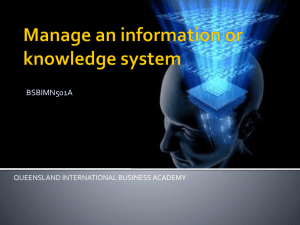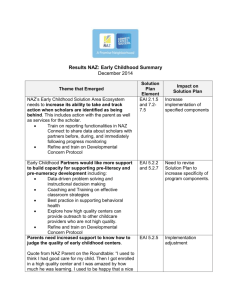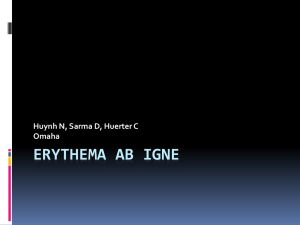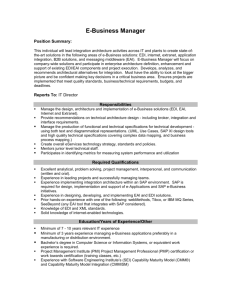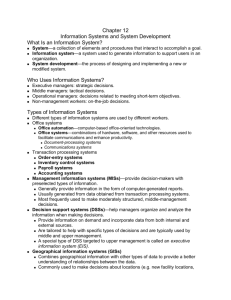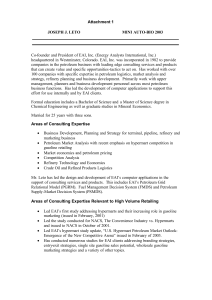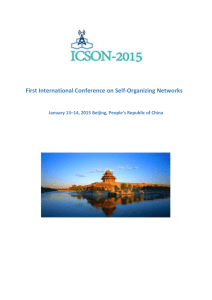Research on Application Integration Solutions of Enterprise Information Yan-hui Hou
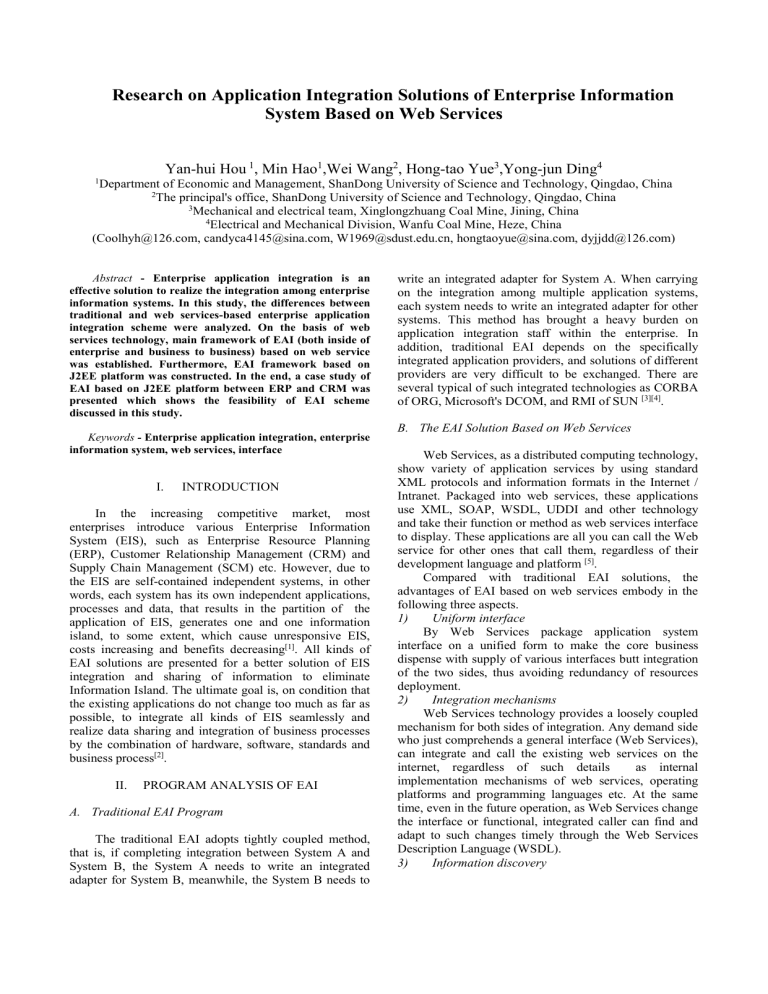
Research on Application Integration Solutions of Enterprise Information
System Based on Web Services
Yan-hui Hou
1
, Min Hao
1
,Wei Wang
2
, Hong-tao Yue
3
,Yong-jun Ding
4
1 Department of Economic and Management, ShanDong University of Science and Technology, Qingdao, China
2 The principal's office, ShanDong University of Science and Technology, Qingdao, China
3 Mechanical and electrical team, Xinglongzhuang Coal Mine, Jining, China
4 Electrical and Mechanical Division, Wanfu Coal Mine, Heze, China
(Coolhyh@126.com, candyca4145@sina.com, W1969@sdust.edu.cn, hongtaoyue@sina.com, dyjjdd@126.com)
Abstract - Enterprise application integration is an effective solution to realize the integration among enterprise information systems. In this study, the differences between traditional and web services-based enterprise application integration scheme were analyzed. On the basis of web services technology, main framework of EAI (both inside of enterprise and business to business) based on web service was established. Furthermore, EAI framework based on
J2EE platform was constructed. In the end, a case study of
EAI based on J2EE platform between ERP and CRM was presented which shows the feasibility of EAI scheme discussed in this study.
Keywords - Enterprise application integration, enterprise information system, web services, interface
I.
INTRODUCTION
In the increasing competitive market, most enterprises introduce various Enterprise Information
System (EIS), such as Enterprise Resource Planning
(ERP), Customer Relationship Management (CRM) and
Supply Chain Management (SCM) etc. However, due to the EIS are self-contained independent systems, in other words, each system has its own independent applications, processes and data, that results in the partition of the application of EIS, generates one and one information island, to some extent, which cause unresponsive EIS, costs increasing and benefits decreasing [1] . All kinds of write an integrated adapter for System A. When carrying on the integration among multiple application systems, each system needs to write an integrated adapter for other systems. This method has brought a heavy burden on application integration staff within the enterprise. In addition, traditional EAI depends on the specifically integrated application providers, and solutions of different providers are very difficult to be exchanged. There are several typical of such integrated technologies as CORBA of ORG, Microsoft's DCOM, and RMI of SUN [3][4] .
B.
The EAI Solution Based on Web Services
Web Services, as a distributed computing technology, show variety of application services by using standard
XML protocols and information formats in the Internet /
Intranet. Packaged into web services, these applications use XML, SOAP, WSDL, UDDI and other technology and take their function or method as web services interface to display. These applications are all you can call the Web service for other ones that call them, regardless of their development language and platform [5] .
Compared with traditional EAI solutions, the advantages of EAI based on web services embody in the following three aspects.
1) Uniform interface
By Web Services package application system interface on a unified form to make the core business dispense with supply of various interfaces butt integration
EAI solutions are presented for a better solution of EIS integration and sharing of information to eliminate
Information Island. The ultimate goal is, on condition that the existing applications do not change too much as far as of the two sides, thus avoiding redundancy of resources deployment.
2) Integration mechanisms
Web Services technology provides a loosely coupled possible, to integrate all kinds of EIS seamlessly and realize data sharing and integration of business processes by the combination of hardware, software, standards and business process [2] . mechanism for both sides of integration. Any demand side who just comprehends a general interface (Web Services), can integrate and call the existing web services on the internet, regardless of such details as internal
II.
PROGRAM ANALYSIS OF EAI
A.
Traditional EAI Program
The traditional EAI adopts tightly coupled method, that is, if completing integration between System A and
System B, the System A needs to write an integrated adapter for System B, meanwhile, the System B needs to implementation mechanisms of web services, operating platforms and programming languages etc. At the same time, even in the future operation, as Web Services change the interface or functional, integrated caller can find and adapt to such changes timely through the Web Services
Description Language (WSDL).
3) Information discovery
The UDDI registry of service-oriented architecture stores information and interaction parameters of all business entity in the way of web services. Companies can find and integrate new business partners and provide the new kind of web services in the spontaneously unattended way [6][7] .
III.
MAIN FRAMEWORK OF EAI BASED ON WEB
SERVICES
For the defects of existing EAI solutions, this paper designs main framework of EAI based on web services
(shown in Figure 1) by the researches of basic technology and enterprise application environments.
A.
Application Integration Based on Web Services inside
Enterprise hand, the application integration based web service within the enterprise provides a good foundation for the application integration across enterprise. Through the web service server (including the SOAP router) calling/ binding web service interface, it can re-package existing enterprise applications and make up the web services with complex function, and publish uniform interface to
Internet [9][10] .
B.
Application Integration Based on Web Services
Business to Business
Application integration between Company A and
Company B is called Business to Business (B2B) integration. Business logic outside enterprises is encapsulated by web services using a unified description of WSDL, and registers in the UDDI center of third-party organizations. Thus, the integration of B2B transforms
Fig. 1. Main framework of EAI based on web services
As Figure 1, the left EAI and right one are called
Application to Application (A2A) integration, which is the basis of enterprise application integration [4] . The specific method is, through the establishment of an internal web services platform (web application server), to carry on web services transformation of the various systems left within the enterprise, namely use business logic of legacy systems to establish homologous web service adapter, and publish it to the internal UDDI (The web application newly developed are registered to the
UDDI through the web service interface). Other systems can call the relevant web service interface before using the related functions [8] . Therefore, the internally original disperse system developed by different platforms, languages, and tools, can be reapplied through the model of web services that not only retains the technology investment existing of business and saves the cost of the new system, but also improves the implementation efficiency of the of new applications, and provides system with an open platform for further expansion. On the other into the butt of Web service. Developers can search
UDDI registry of private enterprises by the public UDDI registry and accesses to the description document of other
Web services WSDL, then automatically services technology, thereby, completes application integration of business to business [11] .
IV.
RESEARCHES OF EAI FRAMEWORK BASED
ON J2EE PLATFORM
A.
Integrated Implementation Framework loads description documents of WSDL into their own platform by Platform tools, and generates the corresponding interface. Developers can quickly understand the data structures of interactive application by XML Schema tools, then just introduces the calling interface and data structure generated by the platform tool into their own applications and uses SOAP to interact with other web
On J2EE Platform, implementation framework of EAI based on web services (shown in Figure 2) includes three parts those are client, middle layer and background system
[5] . Client allows customers to find and call web services in different ways (web browser or enterprise application
Provided by Company Rational. That is, the provider of web services publishes under-integrated services to the
UDDI registry, and then web services requesters find and call these services to realize enterprise application integration [6] .
Fig. 2. Implementation framework of EAI on the J2EE platform Integrated Implementation Process programs), so as to achieve the client's connection. The middle layer is responsible for developing, deploying and publishing web services, and connects client with background system. It also can be divided into presentation layer, business layer and the integration layer.
Presentation layer is comprised of the web components
(JSP, Servlets etc.) and responsible for handling request / response of HTTP, XML and other, session management and calling of the business layer components, etc.
Business layer uses EJB Session Bean to achieve the logic functions of company's core business, meanwhile transforms the related business logic into web services, and published it to the UDDI server; integration layer is responsible for disposing communication and connections between business logic and background systems, such as using EJB Entity Bean to access corporate databases and using J2EE Connector Architecture (J2EE Connector
Architecture, JCA) to reach integrations between business logic and enterprise information systems, etc. Background systems afford supporting environment for enterprise application integration, including corporate databases and enterprise information systems [12][13] .
B.
Integrated Implementation Process
Implementation process of EAI based on web services can be build on J2EE platform through Rational
Rose of Visually Unified Modeling Language (UML)
The Sequence Diagram describes the process of provider developing, deploying and publishing web services on the J2EE platform, including the web services definitions, dissemination. implementation,
The steps are as follows.
1) Definition of web services deployment and
Web services provider chooses EJB Session Bean published, and generates the WSDL description so as to establish the mapping of WSDL to EJB; then to standardize defines of the service endpoint by the JAX-
RPC and define the available methods service endpoints provide.
2) Implementation of web services
Choose a specific service endpoint and implement all the business logic methods the endpoint has defined, and then generate deployment description which defines the information of service name, service target namespace, the required package and class name, etc.
3) Deployment of web services
Establish a deployment package, and position web services into the EJB container of J2EE component. This deployment is made up of description of web services, standards description of EJB components and characteristics description of web services operation.
4) Publish of web services
Use JAXR to publish web services to UDDI registry after it being positioned into the J2EE container.
Since then, information about integrated services that web services providers can provide, has been published to UDDI center, web services requester can view the list of services and call their services needed through accessing the UDDI center [14][15][16] .
V.
CASE STUDIES
ERP, as a kind of universal management platform of enterprise information, implements integrated management of the enterprise's financial, material, product design, manufacturing and human resources; while CRM to enterprise customer as the center, executes
VI.
CONCLUSIONS
EAI based on web services realizes real platform independence and language independence, so that it can easily integrate various enterprise information systems together seamlessly. It is beneficial to the cross-platform interoperability establishment of information sharing and data exchange that the loose joint and dynamic integration use web services.
On J2EE platform, EAI based on web services this paper proposed, not only satisfies the needs of EAI, but also can minimize the complexity of EAI and improve the the collaboration of sales, service and marketing outside enterprise. Enterprises must complete application integration of ERP and CRM before achieving the goal of product design and manufacturing driven by customer and market’s demand.
Shown in Figure 3, in order to achieve the information integration between the product design module of ERP and product demand module of CRM, package business components of CRM related to product demand analysis into the web services through the derivative tool of secondary development interface, and publish it to enterprise UDDI registry. When product design module of ERP needs to call the product information demand analysis of CRM, it can use inductive tool of secondary development interface to search for this kind of service in enterprise UDDI registry and get the WSDL binding information of the Web Services, afterwards the inductive tool of ERP can communicate with derivative tool of
CRM by SOAP, and product demand information is transmitted into the product design module, so as to complete data transfer between the two. On the contrary, the principle is as mentioned above.
Fig. 3. Integration based on web service of ERP and CRM flexibility of whole system. In addition, the development of EAI adopts some technologies of JSP, Servlets, EJB and data exchange supporting for XML, which optimizes the system function and minimizes inter-dependence of technology within system.
R EFERENCES
[1]Therani,Madhusudan,
“An intelligent mediator-based framework for enterprise application integration”, Journal of Computing and In-formation Science in Engineering,
2004(12), pp.294-304.
[2] Zhou Hongsheng, “Research and application of enterprise application integration based on web services”(in Chinese),
Dalian University of Technology, 2005, pp.75-80.
[3] Liu Jinwu, “Achievement of enterprise application integration by web services in .NET technology”(in
Chinese), Kunming University of Science and technology,
2004, pp.27-35.
[4] Mo Xiaojun, “Research on the application of web services in the EAI”(in Chinese), Chongqing University, 2004, pp.41-
50.
[5] Yuan Zhanting, Zhang Qiuyu, Yang Jie, “Research on EAI solutions based on web services”, CIMS, 2004(4), pp.394-
414.
[6] ohannession P, PerjonsE, “Design principles for process modeling in enterprise application integration”, Information
Systems, 2001(3), pp.165-184.
[7] Ferguson, Renee Boucher, “EAI vendors vie on web services”, eWeek, 2001, Vol. 18 Issue 47, pp.14.
[8] Meehan, Michael, “EAI vendors add more support for web services”, Computer world, 2002, Vol. 36 Issue 22, pp.12.
[9] Meehan, Michael, “EAI vendors embrace web services”,
Computer world, 2001, Vol. 35 Issue 50, pp.18.
[10] Walsh, Aaron E.. Dr. Dobb's, “J2EE 1.4 web services”,
Software Tools for the Professional Programmer, 2003,
Vol. 28 Issue 4, pp.34-37.
[11] Houlding, David; Govindasamy, Sekar. Dr. Dobb's,
“Integrating .NET & J2EE with web services”, Software
Tools for the Professional Programmer, 2003, Vol. 28 Issue
9, pp.24-29.
[12] Gutierrez-Garcia, J. Octavio, Ramos-Corchado, Felix F.,
Koning, Jean-Luc, “An obligation-based framework for web service composition via agent conversations”, Web
Intelligence & Agent Systems, 2012, Vol. 10 Issue 2, pp.135-150.
[13] Jarrah, Moath, Zeigler, Bernard, “A modeling and simulation-based methodology to support dynamic negotiation for web service”, Simulation, 2012, Vol. 88
Issue 3, pp.315-328.
[14] Tong, Hongxia, Cao, Jian, Zhang, Shensheng, Li, Minglu,
“A distributed algorithm for web service composition based on service agent model”, IEEE Transactions on Parallel &
Distributed Systems, 2011, Vol. 22 Issue 12, pp.2008-2021.
[15] Serhani, M., Jaffar, A., Campbell, Piers, Atif, Y.,
“Enterprise web services-enabled translation framework”,
Information Systems & e-Business Management, 2011,
Vol. 9 Issue 4, pp.497-517.
[16] Wang, Zhi-Jian, Liu, Zhi-Zhong, Zhou, Xiao-Feng, Lou,
Yuan-Sheng, “An approach for composite web service selection based on DGQoS”, International Journal of
Advanced Manufacturing Technology, 2011, Vol. 56 Issue
9-12, pp.1167-1179.


